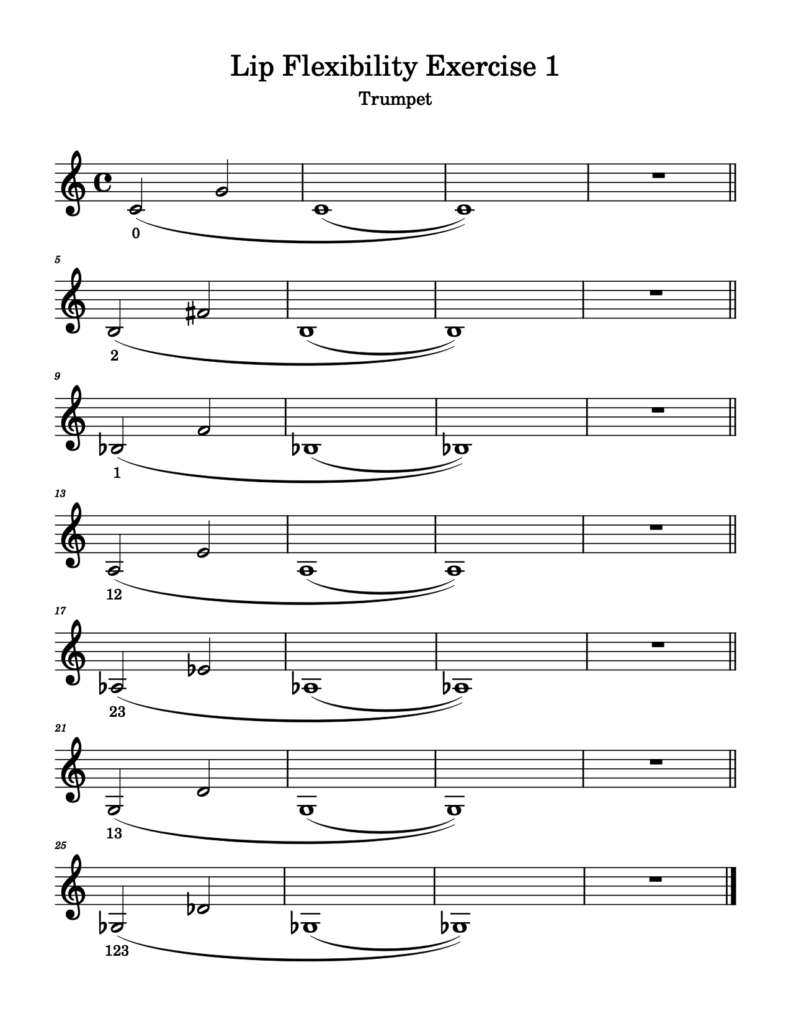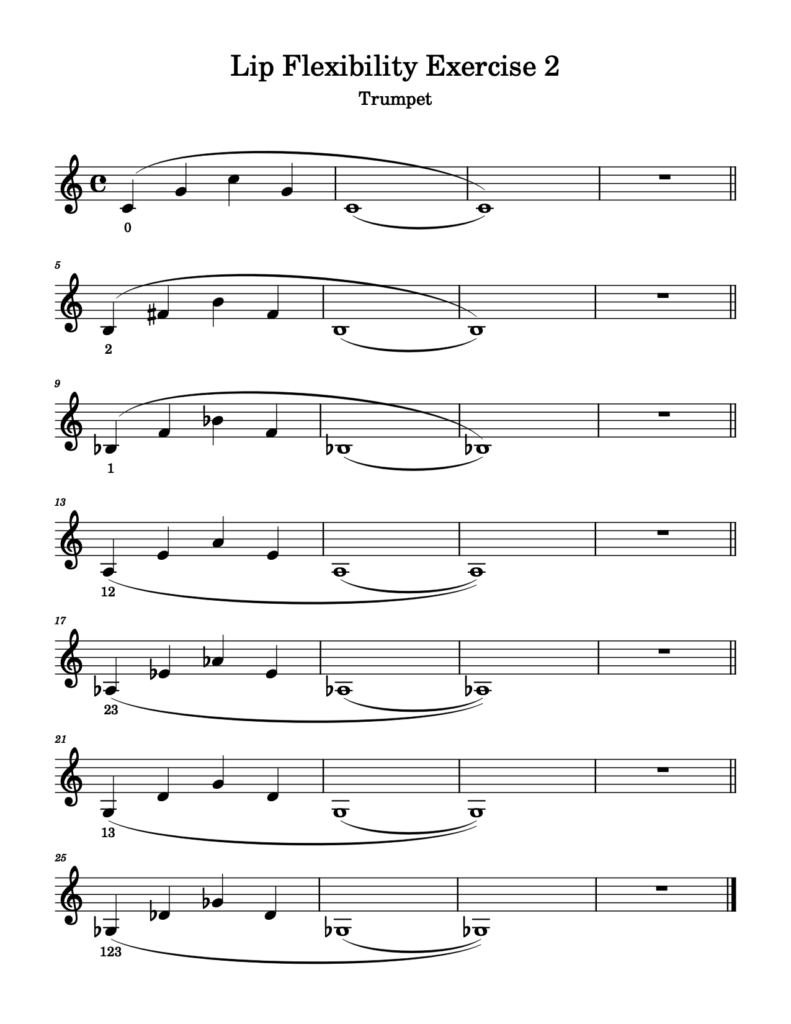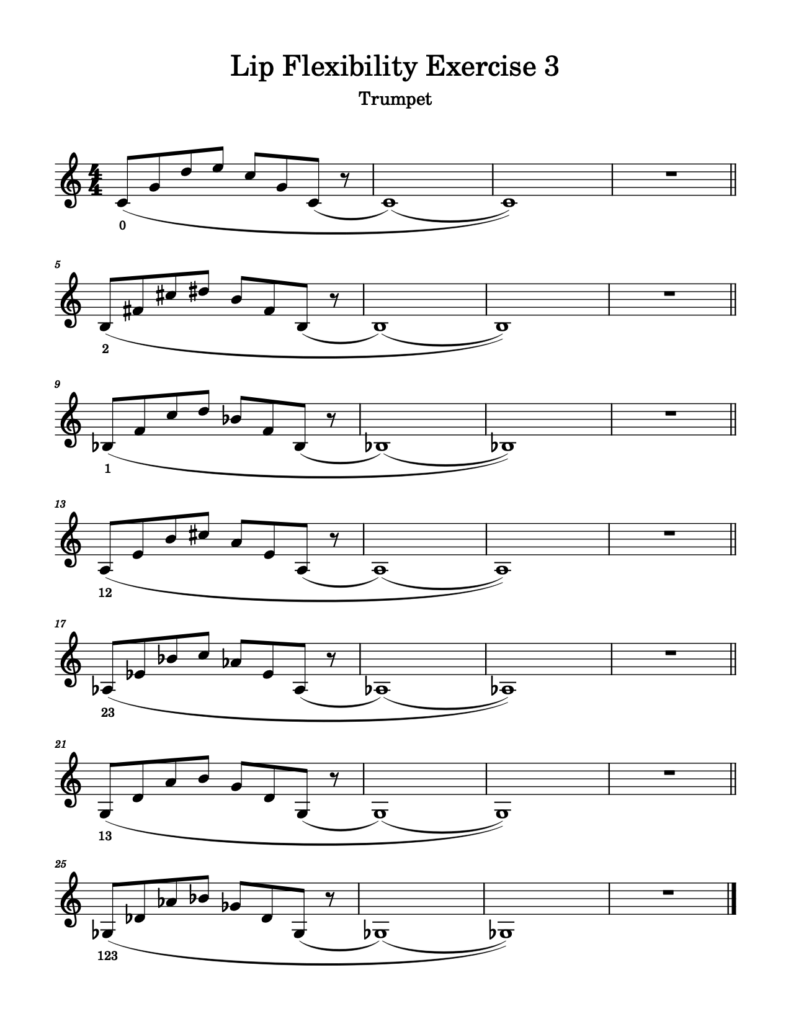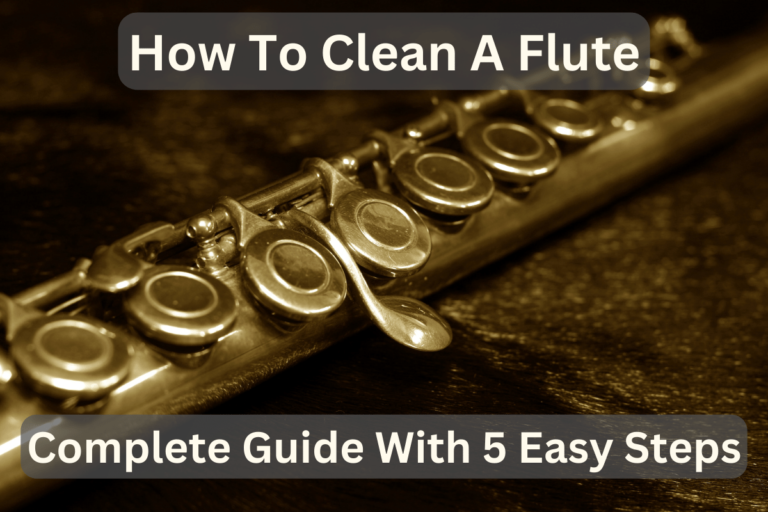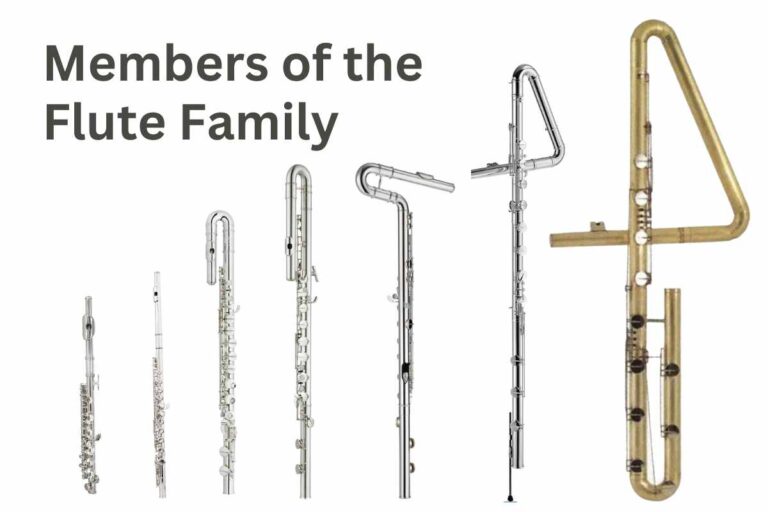7 Proven Trumpet Lip Slurs Exercises PDF — Student-Friendly and Easy to Follow Guide!

Trumpet lip slurs aren’t scary! In fact, they’re super helpful — they train your “embouchure” and “aperture”!
The beauty of lip slurs is their simplicity. You can practice them at any level-beginner, intermediate, or advanced! In this guide, you’ll find 7 easy-to-follow trumpet lip slurs PDFs. They’re simple, clear, and made for students.
When you master trumpet lip slurs, everything else on the trumpet becomes easier! Explore these 7 proven trumpet lip slurs that you should practice daily!
What Are Trumpet Lip Slurs?
Lip slur exercises — also called flexibility exercises — are trumpet techniques that focus on transitioning between notes without tonguing. In these exercises, you only tongue the first note of each section and then slur between notes.
Trupet lip slurs change notes WITHOUT changing fingerings — like going C → G → C with the same valve combination. They’re all about smooth transitions between notes in the same harmonic series.
Lip slurs improve range and develop control, endurance, and flexibility. They also help you recover your sound after taking time off from playing!
The goal is ease of movement around the instrument, not forcing your way to higher notes! Learn to create FASTER air, not MORE air. That fast airstream lets you hit higher notes WITHOUT crushing your face muscles.
Flexibility practice comes third in the warm-up order. The ideal progression looks like this:
- Buzzing
- Long Tones — “5 Trumpet Tone Exercises PDF — Free Sheet Music + Pro Tips For Routines“
- Lip Slurs (You are here!)
- Tonguing
- Range — “Trumpet Range Exercises PDF — 5 Options You Should Practice“
- Warm Down
Pick a few studies from each section — don’t feel like you gotta do every single one. Just grab a few that feel good and hit the basics.
If you run through the full progression (buzzing → long tones → lip slurs → tonguing → range → warm down), it takes about 30 minutes total.
These first few patterns make great warm-ups — use them for your practice!
1-4. Four Lip Flexibility Exercises — Perfect Start For Beginners
The “Four Flexibility Exercises” are the student-friendly way to train airflow and control. They focus on clean slurring across partials.
These trumpet lip slur exercises help you to progress from simple to more complex patterns. Each builds upon the previous one, from low to high range.
Change the pitch by how your lips move and how fast your air flows. The lips control the size of the gap (the “aperture”) — and that gap sets the pitch. Learn more about aperture in my “Beginners Guide — How to Play Trumpet With 15 Best Tips“
Pro tip: don’t lift the tip of your tongue — that blocks the air and makes slurring harder!
You can adjust pitch by changing your tongue position (especially the middle and back). Try whistling high and low — you’ll feel your tongue move without even thinking.
- Key: concert B♭ major
- Time signature: 4/4 (common)
- Range: Low Gb to high G (concert Fb to F)
- Tempo: ♩ = 60–72, moderate or slow
Each phrase in these exercises uses a new valve/fingering combo and interval slur. Everything is legato under slurs — no tongue between notes. This is all about smooth lip-only transitions.
Slur all notes! Only tongue the first note of each group — then no more tongue. Use the same fingering for the full phrase and let your lips change.
Take a breath on beat 4 at the end of each phrase. Don’t hold your breath — stay relaxed and breathe naturally. Stand or sit with good posture. Straight but not stiff — your air needs space to move.
When you play these slur exercises, your lips learn to “find” the note independently! And always use a metronome — it’s your best friend for slow slurs!
5-6. Two Trumpet Lip Slurs Exercises — Continue To Progress
These two Trumpet Lip slurs build your embouchure and give you a clear path to better flexibility and tone. Visual fingering numbers (e.g., “0”, “23”, “123”) make it easy to follow. This lets even beginners focus on form, not guesswork.
- Key: concert B♭ major
- Time signature: 4/4 (common)
- Tempo: Starts slow (♩ = 60) and builds up to 120–160 bpm
The first few lines start very easy — they’re warmups. You’ll play open notes and add the 1st and 2nd valves.
Then, the exercise goes into more movement. Short, smooth lines train your lips to move without a break.
By the last section, you’ll notice faster note patterns. These test how smooth and controlled your air is — but they still sound natural when slurred.
These lip slurs mix steady playing with new challenges. They keep your focus without being overwhelming.
7. Maurice Andre — Trumpet Tongue And Slur Exercise
The “Maurice Andre — Trumpet Tongue And Slur Exercise” (from the legendary French trumpet master) is a must-know piece for all brass players.
This exercise helps build clean articulation and smoother trumpet lip slurs. Students love it because it’s “famous, but friendly.”
Maurice Andre knew exactly how to write exercises that feel good on the lips. You get time to breathe, time to focus, and time to get each sound clean. There’s a great natural flow to the music. It teaches you without shouting at you.
- Key: concert B♭ major
- Time signature: 4/4 (common)
- Tempo: Slow,♩ = 60-80 pbm
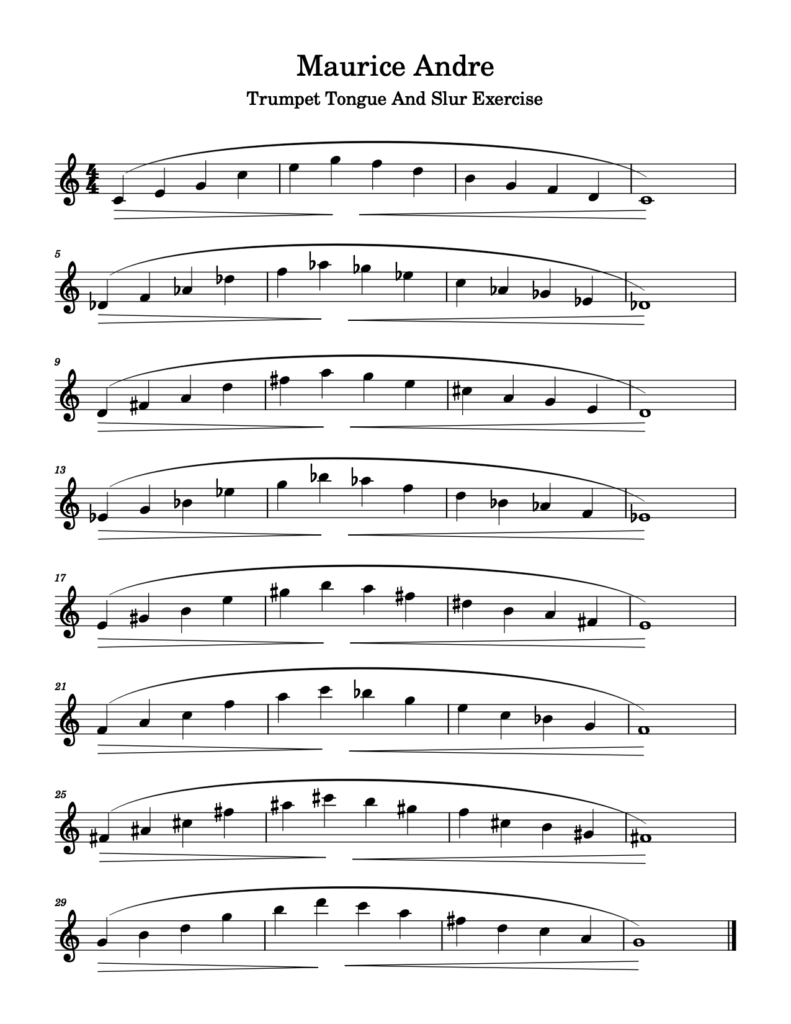
You’ll struggle with connecting the notes cleanly. Your lips’ll want to “jump” instead of glide. That’s normal at first — think “one stream of air,” not “note-to-note.”
Some players get tired too fast. That’s probably an airflow or embouchure issue. Take breaks. Don’t push too hard. It’s okay to rest between lines.
And don’t forget — after every line, take your horn off your face, lower it, and rest. Let your chops recover.
Record yourself now and then. Listen for smooth slurs and clean pitch. Try slurring one day, then tonguing the next. And remember — it’s okay to repeat lines until they feel easy.
Bonus: Two Classic Trumpet Lip Slurs Books Worth Owning
These two books are must-haves for serious trumpet players.
Earl Irons’ “27 Groups of Exercises“ has become a cornerstone of trumpet pedagogy. Trumpet players praise it as “one of the most valuable classic brass books” and “absolutely essential” for daily practice. Many teachers have their students work through this methodical collection of exercises.
Charles Colin’s “Advanced Lip Flexibilities” FREE in PDF takes your practice to the next level. This three-volume collection helps develop range and lip trills. Many players improved in their upper register, with some reaching as high as G above High C.
Teachers recommend a progressive approach: start with Vol. 1 #1-3, Vol. 2 everything to ‘E’, and Vol. 3 Section 1-A, B, C for the first week. Then gradually add more challenging exercises as your flexibility improves.
Both books complement each other beautifully in a comprehensive practice routine!
Top Tips For Trumpet Lip Slurs Practice
Lip slur helps you feel where your tongue should sit. You should NOT use pressure or fingers — just air and tongue to move from one note to the next.
When practicing lip slurs, focus on smooth transitions without “cracks” between notes. Maintain a relaxed, open throat and AVOID tension in your upper body.
Try this: slur from middle C to high E with open valves. Since you ain’t using valves, it’s ALL about where your tongue sits. If it’s in the wrong spot, the note sounds off.
Depending on your goals, practice 5-30 minutes of lip slurs. Match this time to how much time you spend strengthening your embouchure.
Make that “tssss” dentist noise by curving your tongue like an upside-down hill. Make that sound, then try playing with your tongue in the same position.
Using vowel shapes-“ee” to go up and “ah” to go down. This tongue movement directs airflow and changes pitch without straining.
Keep a mouthpiece in your car for quick buzzing sessions when stuck in traffic — even a few minutes of lip buzzing helps loosen up your embouchure!
Don’t skip the “long positions” (combinations like 1-2-3). These require finer embouchure control since the harmonics are more closely spaced, making them excellent training exercises.
A great way to evaluate if you’re doing enough lip slurs is to ask yourself: “Do my lips feel good?” If they feel alive and fresh, you’re getting enough flexibility work. If they feel stiff or tired — practise more trumpet lip slurs!
Conclusion — Trumpet Lip Slurs
Trumpet lip slurs feel tricky at first — but they’re totally worth it. With just a few minutes daily, you’ll hear big improvements in your sound, range, and flexibility.
Don’t try to rush. Take it slow. Focus on smooth air and steady lips. Over time, your chops will get stronger, and playing will feel more natural.
Grab the “7 Proven Trumpet Lip Slur Exercises” PDFs and make it part of your daily warm-up.
Keep practicing, stay patient — and remember: every great player started right where you are now!! 🎺

